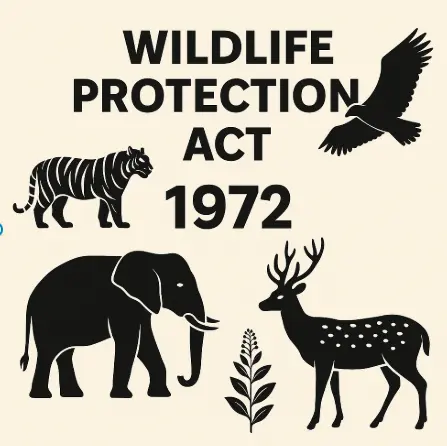
Introduction
The Kerala Cabinet has passed an amendment bill to change the Wildlife Protection Act (WPA), 1972, an important law regarding the protection of wild animals and their habitat in India. The Amendment Bill proposes to simplify procedures to kill wild animals, which are threatening human life. We should see its relevance in light of escalating incidents of wild animals attacking humans, especially in areas where human-animal conflicts are becoming more pronounced.
This is significant because it is the first state to introduce amendments to a central wildlife law. While it signifies the urgency to address the growing cases of wild animal attack, it also raises the question of legality and constitutionality: Can states amend a central legislation like the WPA ?
Wildlife Protection Act, 1972
The Indian Parliament passed the Wildlife Protection Act in 1972 as a framework legislation to protect the country’s flora and fauna. The main objectives of the Act is as follows:
- Regulate hunting, poaching and trade of wild animals and plants
- Create a structured Protected Area Network which includes:
- National Parks – highly protected zones with prohibition on grazing and commercial activities
- Wildlife Sanctuaries – organized zones with limited activities allowed
- Conservation Reserves – Government owned buffer land that also acts as a corridor for the movement of wild animals.
- Communities own and manage Community Reserves, which are formally recognized areas protected sustainably from human-induced threats.
Statutory authorities
The Act also established statutory authorities that would function effectively in implementation:
- National Board for Wildlife (NBWL): The Prime Minister heads this apex authority, which makes national-level wildlife decisions, including changes to boundaries of protected areas.
- State Boards for Wildlife: The Chief Minister of each state or union territory heads these boards, which make state-level wildlife decisions.
- Central Zoo Authority – administers zoos and animal exchanges between zoos.
- National Tiger Conservation Authority (NTCA) – manages tiger reserves under Project Tiger.
- Wildlife Crime Control Bureau (WCCB) – looks after other illegal wildlife trade.
The other major feature of the Act is the classification of species under Schedules, which provide for Schedule I animals (such as tigers and lions) the best protection.
The Act was also shaped by international obligations and constitutional obligations:
Internationally, it would follow (or after) the Stockholm Conference of 1972, where it was agreed that India would give stronger environmental protections.
The Constitution aligns wildlife protection with the Directive Principles of State Policy (Article 48A), which direct the State to protect and improve the environment, and with the Fundamental Duties (Article 51A(g)), which oblige citizens to protect wildlife and natural resources.
Kerala’s Planned Amendment
The amendment bill sanctioned by the Kerala Cabinet proposes maximum new measures to amend the application of the Wildlife Protection Act, 1972, in the state. Among its most substantive features is that it allows for the Chief Wildlife Warden (CWW) to directly direct the killing of any wild animal that attacks human beings in human-inhabited areas. This is a notable change in law, because currently under the provisions of the WPA, a CWW can only provide a permit for hunting or capture of wild animals listed in Schedule I to IV if they become dangerous to human life.
Another primary proposed amendment by Kerala is to allow the state government to declare animals listed under Schedule II as vermin. Currently, the Central Government alone can declare certain wild animals (not listed under Schedule I or Part II of Schedule II) as vermin under Section 62 of the Act. Once declared vermin in Schedule V, people may hunt or kill these animals within specified areas and for a limited period.
As a result, the proposed amendment begins a federalism discussion: can a state change the powers of a central legislation? Critics argue that these provisions will create constitutional issues because the WPA is a central legislation under the Concurrent List, and a state amendment can take effect only with the President’s concurrence.
Human-Animal Conflict in Kerala
The background context for the Keralan amendment proposal is an increase in human-animal conflicts in the state. Kerala has large forests, plantations, and fragmented habitats and is part of the Western Ghats, both of which are biodiversity hotspots where humans and wildlife often meet.
In recent years, there have been an increase of tensions between local populations and conservation authorities due to elephants raiding crops, wild dogs attacking domestic animals and people, and occasional encounters with tigers. The districts of Wayanad, Palakkad, and Idukki have had many human deaths and injuries from animal attacks. For example, elephants trampled farmers and wild boars injured them in Wayanad, triggering significant public outrage.
These ongoing tragedies have resulted in protests and political action as communities affected by these tragedies advocated for faster and stronger steps to keep them safe. The government at the state level asserted that the amendment was necessary to implement a more practical framework, claiming the blanket central law is too prescriptive and prevents timely action in situations of conflict.
The Historical and Cultural Importance of Animals in India
The connection between humans and animals is not solely ecological but is rather cultural, spiritual, and historical as well.
- Indus Valley Civilization: Archaeological discoveries such as the Pashupatinath seal, one of the more notable finds, featured a proto-Shiva figure surrounded by animals, which indicated early Indian society’s reverence and respect for wildlife.
- Temple Architecture: In South India, artisans decorated temple walls and gopurams with elaborate carvings of elephants, lions, and mythical yalis (lion-like creatures) to depict themes of power, protection, and divine guardianship.
- Animals in Art: Moreover, Animals have remained central to Indian art and to the state in a symbolic sense from ancient coins and sculptures, all the way to classical painting.
- In Indian religion, deities often associate with animals—for example, Ganesha with elephants, Durga with the tiger, and Nag deities with serpents.
- In Kerala, animals constitute integral components of social and religious traditions. There are temple festivals such as the Thrissur Pooram where elephants are part of ceremonial decorations and displays. The connection between humans and elephants has resulted in elephants being seen as cultural symbols, but equally so, there can be conflicts between the traditions and animal welfare and conservation outcomes.
Hence, This historical context suggests that wildlife India has always been an intrinsic part of its civilizational identity and will provide an even greater substratum for the discussions on wildlife protection and human-animal conflict.
Read about- The 130th Amendment Bill, 2025
Wildlife Protection Act – Schedules and Amendments
The Wildlife Protection Act (WPA) of 1972 lists flora and fauna in various Schedules determining various levels of protection for the species. Earlier, There were six schedules, and an amendment in 2022 reduced them to just four to help with clarity and uniformity with codified international conventions on wildlife protection.
Schedule I: It provides the most comprehensive style of protection; even the species protected in Schedule II do offer a lesser degree of protection; crimes against these species have the greater consequences. Examples: tiger, Asiatic lion, blackbuck.
Schedule II: It provides a more extensive degree of protection but still below Schedule I, it allows for some forms of regulation that can be governed in the protected wildlife.
Schedule III: It applies to wild plants, regulated by a prohibitive method to extract or cultivated without authority. Examples: Neelakurinji, orchids like Blue Vanda and Red Vanda.
Schedule IV: It applies to species listed (CITES – Convention on International Trade in Endangered Species) appendices.
Significant Features of 2022 amendment
- CITES Compatibility: Enhanced India’s adherence to wildlife trade practices governed by international agreements.
- Schedules Reduced: Schedules previously numbered six were reduced to four for convenience.
- Vermin Removal: The distinct Schedule V for vermin has been deleted, but the power to declare any wildlife species vermin rests with the Union government.
- Captive Wildlife Rules: The rules with regard to keeping and transferring live animals will have more stringent rules instituted in terms of registration.
- Elephant Removal: The amendment has established an exemption to allow elephants to be transferred for religious or cultural purposes, which erupts controversy based on the risk of exploitation of animals.
This amendment demonstrates India’s attempts to update and modernize its conservation law, all the while balancing international commitments to conservation and maintaining its cultural practices.
Key Legal & Constitutional Issues
The most important issue that has arisen by Kerala’s proposed amendment is: Can a state government amend a central act (Wildlife Protection Act 1972)?
The WPA falls under the Concurrent List, specifically Entry 17B – Protection of wild animals and birds; thus, both the Union and state legislatures may make laws on the subject. However, because the WPA is already a central act, any amendment(s) by a state will require the assent of the President of India, for it to be valid. Until the state law is assented, the State Law will simply not operate.
Conclusion
The Wildlife Protection Act of 1972 is part and parcel of our legacy in conservation and responsible for avoiding the extinction of tiger and one horned rhinocerous populations. However, the preservation and responsible management of wildlife in the 21st century with the rapid growth of urban communities displacing wildlife habitat and the impact of climate suggest the need to reconsider our approach.
The proposed amendment in Kerala captures a genuine dilemma: the need to safeguard human life as well as wildlife. It raises larger questions of the scope of federal powers and responsibilities, ethics of decision-making, and living sustainably with wildlife.
The way forward must involve a combination of science, law, and community participation so that India does not surrender either human safety or its millennia-old cultural and ecological relationship with wildlife.
- Enhancing mitigation: establish early warning systems, build protective barriers around farms, and when achievable, relocate destructive wildlife.
- Introducing technology: use GPS collars, drone technology, and AI-based tracking systems to understand animal movements and understanding situations at risk of conflict.
- Engaging communities: engage local communities in conservation programs alongside compensation programs, thus engaging those directly impacted to an extent that they start to see wildlife as an asset instead of a threat.
FAQs on Wildlife Protection Act, 1972
The WPA was established to protect the flora and fauna of India. Its objectives were to prohibit hunting, regulate trade of wildlife, and provide a legal framework for protected areas like National Parks and Sanctuaries. WPA also provided a means to fulfill India’s international commitments following the 1972 Stockholm Conference.
National Parks – most regulated and protected areas – no grazing and no commercial activities.
Wildlife Sanctuaries – allow some regulated activities.
Conservation Reserves – government land which provides buffer or corridors.
Community Reserves – land owned by a community and where conservation occurs with local participation.
National Board for Wildlife (NBWL) – chaired by Prime Minister.
State Wildlife Boards – chaired by Chief Minister.
Central Zoo Authority.
Wildlife Crime Control Bureau (WCCB).
National Tiger Conservation Authority (NTCA).
Right now, the only entity who can declare animals vermin, except for those in Schedule I and Part II of Schedule II, is the Central Government under Section 62. This allows for the controlled killing of those animals.
Yes, wildlife is in the Concurrent List, so states can seek to amend the act, but the amendment would require the President’s assent in order to be valid; otherwise, the central law shall take precedence.
Directive Principles (Art. 48A): the state shall protect the environment and wildlife.
Fundamental Duties (Art. 51A(g)): Every citizen must protect and improve the environment and wildlife

